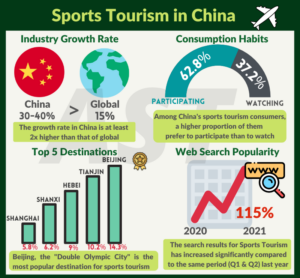
Why China now?
The government’s strong policy is creating many business opportunities to support China’s sports and fitness sector to grow rapidly and help it to flourish. With the Beijing Winter Olympics approaching and the nationwide fitness boom accelerating, companies should seize the opportunity now to expand in the market or invest. The future is promising if companies adopt the right strategies to enter and capture the fast-growing sports and fitness market opportunities in China.
China has been putting more work into promoting an active lifestyle over the past two decades and the State Council of China announced in August 2021 its latest National Fitness Program for 2021 to 2025. The major goals are to get 38.5% of the overall population exercising regularly, and the sports industry to be worth US$774 billion by 2025, showing Xi’s ambitions in making sports and fitness a key pillar of their economy. Key initiatives include: enhancing youth sports education (See previous article on how technology can increase youth engagement in sports); increasing public sports venues and facilities; hosting more public sports games and competitions; and modernizing the sports industry and further developing sports tourism.
The new policy will accelerate the industry and create a favourable environment for sports and fitness companies to grow their impact in China.
1. Favourable investment climate for the sports & fitness market
China’s total output value of the sports industry has reached about US$ 458 billion (2.95 trillion RMB), and with US$ 170 billion (1.1 trillion RMB) added value by 2020, accounting for 1.2% of China’s GDP. The number of fitness clubs went up almost 1000 times in 18 years, from approximately 500 gyms in 2001 to 49,860 in 2019, catering to the 68 million strong fitness population. The fitness population penetration rate in China is relatively low compared to foreign markets at only 4.9% while the penetration rate in US, UK and Germany are: 20.3%, 14.9% & 13.4% respectively according to the 2019 China Fitness Industry Data Report by IHRSA, however, there is a very large opportunity and a very large gap to fill.
China’s sports and fitness sector has always been appealing to investors, resulting in exponential growth in the market. According to Deloitte, 39 public investment and acquisition cases with a total value of US$754 million (4.8 billion RMB) were recorded in 2019. One of the most successful fitness apps in recent years – Keep just raised US$ 60 million in funding led by SoftBank earlier this year with a US$ 2 billion valuation.
Sports and recreational facilities also saw growth. Over 5,700 projects subsidized by the Government have been implemented, and many old factory buildings, warehouses and unused land have been transformed into sports areas from 2016-2020. Private companies also stepped in, China’s first-ever PPP Sports fund with US$1.5 billion in initial funding was co-established by Everbright Securities and Zhejiang Kunlun Holding Group in 2016 to finance the infrastructure projects for the Beijing 2022 Winter Olympics as well as Hangzhou 2022 Asian Games and a sports park in Beijing. In line with the goal of having over 2,000 sports facilities and public stadiums established or expanded by 2025, the private sectors’ involvement will be highly valued.
Growing interest in health and fitness by the Chinese population also boosted related consumption as it tends to spend more on gym memberships, sports apparel and equipment or seeking professional coaches or trainers.
With the aim of reaching US$774 billion (5 trillion RMB) representing 3.3% of China’s GDP by 2025, the sector is continuing to emerge and diversify at a rapid speed, and attract more capital flow.
2. Bolstering growth in digital fitness
Although the Chinese government stated they are looking to increase the number of fitness instructors to more than 2 sports instructors, on average, available to every 1,000 residents, it is still inadequate to satisfy the growing demand given such a huge population in China.
On the other hand, China’s fitness industry underwent a significant pivot under the pandemic, as the digitization of the fitness industry accelerated drastically. Consumers these days prefer digital fitness solutions over traditional gyms and equipments, with 57.8% of the respondents said they use fitness apps and 21.9% of them own wearable equipment according to a survey on Consumption Habits in Sports of Chinese Consumers by Daxue Consulting in 2021. Additionally, 51.5% of the respondents prefer to exercise at home. Deloitte’s “2019-2020 China Gym Market Development White Paper” also indicated that from January to May 2020, the number of monthly active users of fitness apps grew to more than 77 million. Compared with the same period (January to May) in 2019, the number of monthly active users in 2020 saw an increase by 11% to 24% each month.
A report from Shanghai-based consulting firm Meritco Services in 2018 stated that internet-based innovative gyms will command a 38% market share with traditional facilities narrowing their share to 34% by 2021. New-model gyms that combine online & offline experiences like Super Money & LeFit are outgrowing traditional gyms.The fitness scene in China is moving towards a digital and gamified future: “phygital” workouts, online live streaming classes, fitness apps or connected fitness. If the aim is to ensure that 38.5% of China’s 1.4 billion population exercises regularly by 2025, it could be challenging to only rely on traditional-model gyms without incorporating technology, especially when they have to meet the needs of millennials who possess strong purchasing capacity.
3. Sports Tourism: An underlying yet massive opportunity
The integration of sports and tourism will be a strategic focus to support the “Healthy China” Plan. Data from the World Tourism Organization and China National Tourism Administration shows that sports tourism is the fastest growing market segment in the global tourism industry with an average annual growth rate of about 15%. While China’s sports tourism market is growing at a rapid rate of 30% – 40%, which is about 2-3 times higher than that of the global market.
“China Sports Tourism Consumption Big Data Report “2021” also indicated that in the first half of 2021, the search popularity for “sports tourism” increased by 115% over the same period of 2020. The top 5 destinations for sports tourism in China are Beijing (14.3%), Tianjin (10.2%), Hebei (9%), Shanxi (6.2%) and Shanghai (5.8%) while Beijing – the “Double Olympic City” is the most popular as the Olympic venues have turned into iconic tourist attractions. Winter sports & ski resorts are trending in north and northeast China, and for central and western regions, there is rising popularity in desert exploration as well as extreme sports such as canyoneering and mountain biking. The report also indicated that the consumers in the sports sector are not only enthusiastic about watching sports (37.2%) but are even more keen on participating at 62.8%.
To tie in with the goals of the national fitness program, sports tourism will play an important role in cultivating a more active culture as it is an easier way to get people engaged in sports. It also caters to both domestic and global consumers, forming a more diverse sports ecosystem in China through building relevant facilities and delivering top-notch sports tourism projects. To increase attractiveness in these facilities, it will be critical to strategically incorporate sports creatively in urban design and to blend innovative technologies to craft immersive experiences.
Looking to better understand investment opportunities and learn how to get your customers in China? We have previously assisted digital fitness apps with China market entry, reach out to us to learn more!








